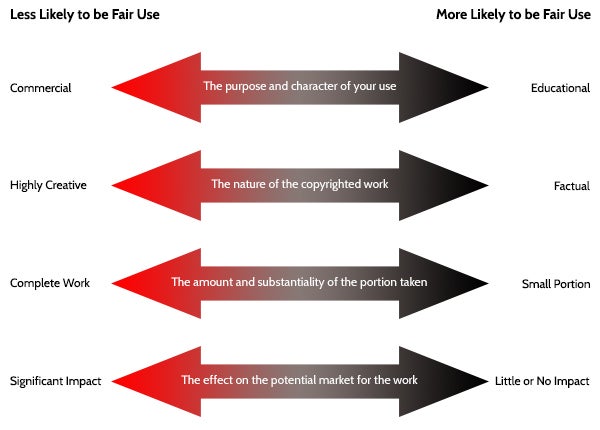Under U.S. copyright law, the creators of original works own the copyright in their works as soon as they are fixed in a tangible form. (17 U.S. Code § 102) Creators have the exclusive right to reproduce, distribute, adapt, perform, and display their work. (17 U.S. Code § 106) Our copyright law includes some exceptions to those exclusive rights, including fair use. (17 U.S. Code § 107)
Fair use is a legal doctrine that allows you to use copyright-protected material under certain circumstances without getting permission from the copyright owner or paying any license fees. Fair use allows you to use limited portions of another’s work, including text, images, video, and music, in your new work. Some examples of fair uses are teaching, scholarship, research, criticism, commentary, news reporting, and parody.
Society benefits from allowing new works to build on existing works, allowing a greater flow of ideas and advancement of knowledge. For example, when scholars quote from previously published copyrighted works, they build on the prior knowledge and create new knowledge.
For an overview of fair use, see the Association of Research Library's Fair Use Fundamentals infographic.
Unfortunately, the law and subsequent court cases do not provide a lot of guidance on which uses are fair and which are infringing. There is no formula, percentage, or amount of a work that is automatically deemed to be fair use. Fair use determinations are made by evaluating what type of work you are using, how much of it you are using, and how you are using it. Fair use analysis is always done on a case-by-case basis and is subjective and fact specific. To determine whether a use is fair or not, four factors must be weighed and balanced. All of the factors must be evaluated, although the relative importance of individual factors will vary from case to case. Rights holders and users of copyrighted materials do not always agree on whether a use is fair, so conflicts can arise, and a particular use could be challenged by the copyright holder.

The Purpose and Character of the Use. Using material in a non-commercial environment and for a nonprofit educational purpose, such as criticism and commentary, is generally favored under the fair use analysis. Courts will also look to whether the use is “transformative,” meaning that you did not just copy the original, but added new expression or meaning to it.
The Nature of the Copyrighted Work. Using material from primarily factual works is more likely to be considered fair use than using material from highly creative works, such as poems, films based on fictional stories, novels, music, etc.
The Amount and Substantiality of the Portion Used. There is no legal formula or rule to determine what percentage or amount of a copyrighted work you can use under the fair use doctrine. Using small portions from a copyrighted work is more likely to be considered fair use than using a larger portion of the work. A court would evaluate both how much of the work was used and its relationship to the full work.
The Effect of the Use on the Potential Market for or Value of the Copyrighted Work. A court will evaluate if and how the market value of the copyrighted work is affected by your use in determining whether it is fair. Note, however, that a court will look only to uses that could be a substitute for the original work, not potential market loss due to criticism of the work.
For an example of how a court analyzed the four fair use factors for course readings in recent litigation over electronic course reserves, read this 2016 district court opinion in the Georgia State reserves case. The court’s very detailed review goes into depth in its analysis of factors 2, 3, and 4 for each copyrighted work considered. The fair use analysis of individual works begins on page 20. The court’s analysis of the 48 readings in question continues through page 211.
For examples of how the four factors have been weighed and balanced by different courts and which uses have been determined to be fair use by the courts, review the case summaries in the Fair Use Index (Copyright Office) or from Copyright & Fair Use (Stanford University). To find the full text of these cases, try Justia, Findlaw, a Google search, or a law library.
"Fair Use" by Georgetown University Library, used under CC BY-NC 4.0 / Library-specific information adapted for the University of Denver.
